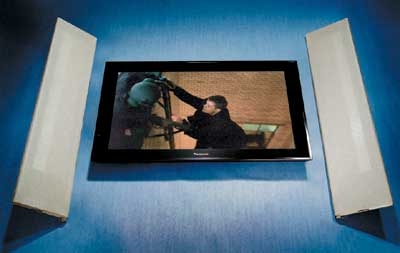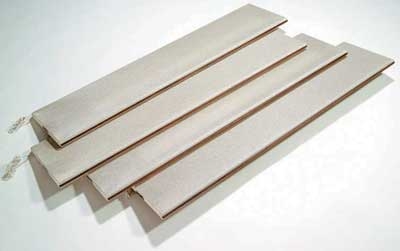Right On! Page 4
MagnepanSwing out, sweet dipoles
And now for something completely different from Magnepan, a name synonymous with flat-panel speakers for more than a quarter-century. Like most "Maggies," the Magneplanar MC1 speaker is a hybrid, combining a large planar-magnetic driver for the bass and midrange with a ribbon tweeter in a flat panel about the size and depth of a window shutter. 
SETUP You mount the MC1s on the wall with very simple hinge brackets that let you fold them away almost totally flat - less than 2 inches deep - when off duty, or swing them out at 30° or so for action. This swinging-door design serves two purposes. First, like virtually all panel speakers, the MC1s are dipoles, which means they radiate the same sound from the front and back, but out of phase. Swinging them out reduces the front/back cancellations that can wreak havoc with tonal accuracy. Second, adjusting the angle also lets you control how much direct or reflected sound reaches your ears, which has an impact on the perceived depth of the sonic image.
|
Magnepan sent three pairs of MC1s, suggesting that one pair be placed well to either side of the TV, the second pair bordering the screen to serve as dual center speakers, and the third pair in the usual side-wall surround positions. I followed this recommendation closely, mounting the front L/R pair about 4 feet from each side of the screen and the center pair (wired in series) flush to it. The L-shaped brackets need only one screw each, but the short input cables are hard-wired, so you'll need to splice on your own extensions. Magnepan doesn't make a subwoofer, but the MC1 system needs help at the bottom end, so I used my regular sub, a Velodyne DD-12 ($2,399).
MUSIC PERFORMANCE My experience with panel speakers goes back to the KLH 9s and Quads of the wacky '70s, but it's been a while since I've had any in my system. Playing two-channel music, the Magneplanar MC1s made me sit up and smile. It's hard not to love the deep, spacious, effortless sound that dipole panels can deliver from a really well-produced CD, like Mark Knopfler's latest, Shangri-La.
The Maggies were highly transparent, with impressively accurate tonal balance. This made them slightly brighter and less rich in the lower voice regions than the Atlantic Tech and Klipsch systems, both of which were slightly warmer.
As with any dipole design, all those room reflections made a difference. In my studio, centered soloists sounded slightly less distinct and "right there" than with an excellent pair of box speakers. But the Maggies' tendency to accentuate reverberant material made the soundstage depth more palpable.
Each adjustment in the outer front pair's angle from the wall changed the intensity of these effects, and to a lesser degree their overall tonal balance. Fortunately, finding the "sweet angle" each time isn't as hard as you might think.
Like most panels, the MC1s aren't jam-kickin' rude boys. They'll play plenty loud, if not as loud as the Klipsch or Atlantic Tech system. And in a quiet room, which preserves dynamics, they'll deliver lifelike impact and detail.
MOVIE PERFORMANCE With all six Magneplanar MC1s (plus the Velodyne sub), 5.1-channel movie soundtracks produced as large and seamless a sonic "bubble" around the listening position as I've heard in my room. I was swept into the movie in scenes with enveloping sound, like the South Atlantic storm in Master and Commander, and certain surround effects sounded eerily natural - like the moment in Chapter 15 of The Bourne Supremacy when a car pulls away from front center to rear left.
Swinging the pair of center speakers out about 45° kept voices anchored to the screen as long as I stayed fairly close to the center. Further off to the side, voices "pulled" slightly to the closer speaker. One way to address this issue - as well as the awkwardness of having to place four MC1s across the front of the room - would be to use a single center speaker placed horizontally. Magnepan makes a horizontal center speaker, the CC3 ($990), a curved dipole design that can't be wall mounted but could be positioned above or below a TV. I didn't have a CC3, but I tried a conventional center speaker I had on hand, and while it would have needed more tweaking to optimize the setup, it was a promising experiment. 
The dramatically different Magneplanar MC1 system breaks the "rules" of cinema sound, which attempt to take the room out of the equation by limiting reflections in the front of the theater. That's the opposite of what dipoles try to do. But no matter: the proof is in the listening, and this setup sounded great - even seductive, making me want to listen more and more.














































